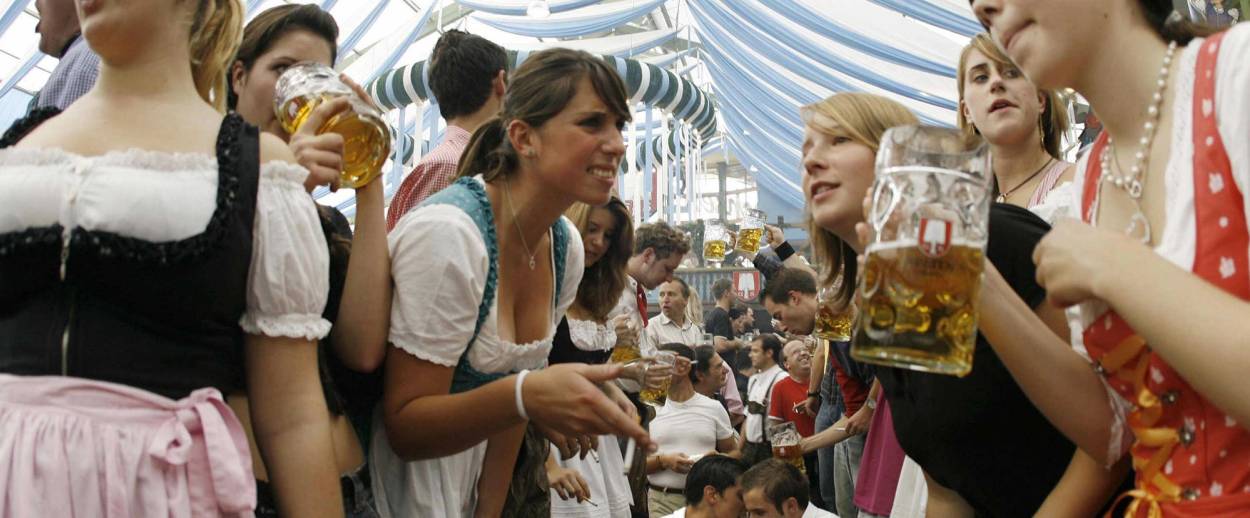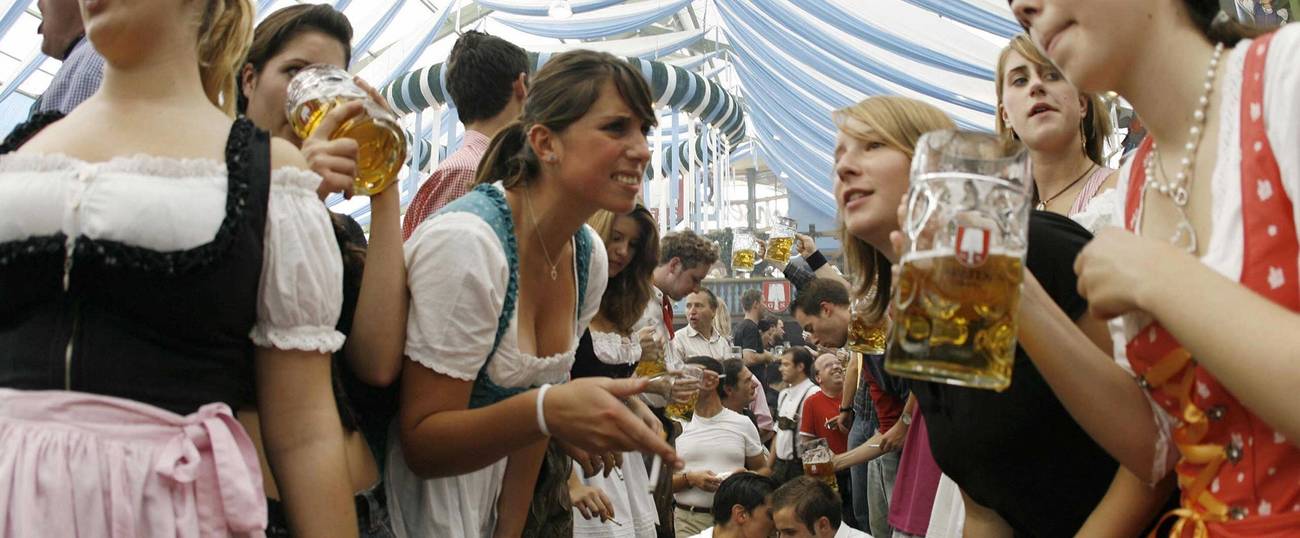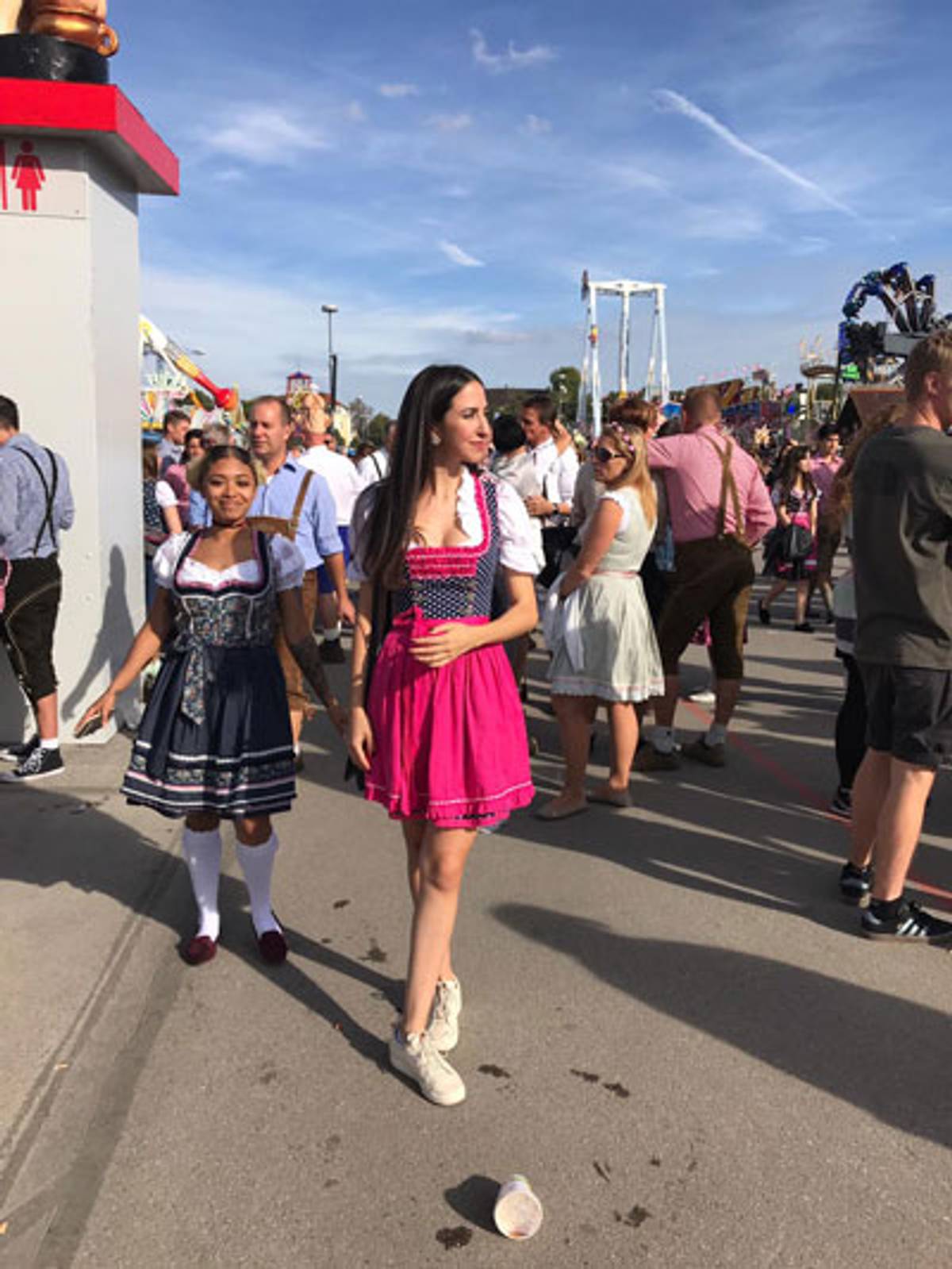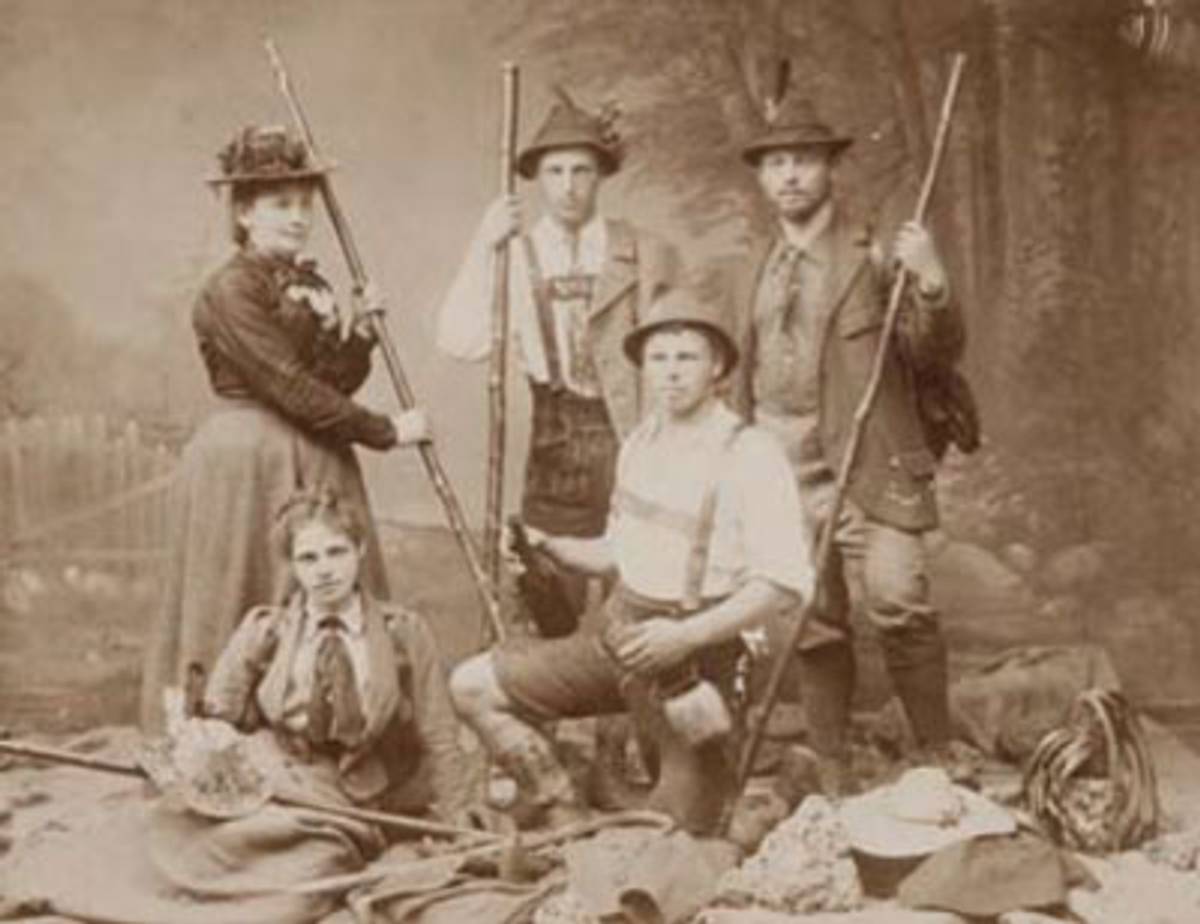A New Spin on Traditional German Clothes
Can Jews really reclaim dirndls and lederhosen, once closely associated with Nazis?




Like many German kids growing up in the 1990s, Lea Krichely only ever saw tracht—traditional German clothing: the busty, floral two-piece dresses known as dirndls and the three-quarter leather breeches known as lederhosen—in old movies, often portrayed as curiosities of the mountain hillbillies. Few spoke of tracht’s past status as the once-official ensemble of the Nazi party. But when Krichely—at 19, looking for a university in a city with a larger Jewish community than in her native town of Karlsruhe—moved to Munich, she purchased her first dirndl: blue and pink, with the traditional Bavarian apron tied around in front.
She had heard that the peasant costume had begun to make its mark as an alternative to T-shirts and jeans at Oktoberfest, Munich’s two-week-long, tented drinking event, most commonly associated today with hordes of drunken visitors gorging on sausages and sauerkraut and dancing to hokey accordion music. When Krichely arrived in Munich, she realized that the dirndl has actually gone beyond Oktoberfest and into the mainstream, as a fashion staple at nightclubs, bars, and even the office.
“All of my Jewish friends wear it,” she told me. “We know that it’s very German, and even [its history as a Nazi symbol] would never hold us back from wearing it now. We want to keep living here, to be a normal part of the community.” They also want to take part in the resurging conversation around German national identity that takes on particular prominence in Munich, the culturally distinct Bavarian capital, said Krichely.
In recent years, Munich’s economic boom and enviable standard of living have fueled a renewed appreciation of traditional institutions, many of which are deeply linked to Alpine culture, like the Oktoberfest beer festival. The city’s tourism offices have long emphasized its uniqueness from the rest of Germany. But some of that uniqueness is wrapped up in the history of Nazism in the region.

Bavaria has a complicated relationship with its WWII legacy. While the region expressed substantial resistance to the Nazis, particularly from Catholic constituents, Munich was the party’s nerve center. Hitler dubbed it the “capital of German art” and the “capital of the Nazi movement.” Following the war, the bombed-out city chose to restore its prewar past, placing a heavy focus on its royalty class, while also keeping many Nazi buildings intact, sans swastika. “The desire for a new beginning, independent of the past in toto, was rooted in an escapist disposition, if not in the outright ‘repression of guilt,’” wrote Gavriel Rosenfeld in his book Munich and Memory: Architecture, Monuments and the Legacy of the Third Reich. Many German critics argue that the region, which grew to become a political base for the Christian Socialist Union, the offshoot of the ruling Christian Democratic Union party formerly under Angela Merkel, has avoided confronting its past.
But the historical reckoning is finally starting to take shape, surprisingly, fueled by kitsch movements like the tracht trend. Its pioneers are millennial Germans, who, compared to their parents’ and grandparents’ generations, feel less guilt about, and more willingness to confront, their German nationalism. They are proud of their heimat, a German phrase that roughly translates to patriotism and national belonging, but was long considered taboo.
“Unfortunately, Hitler took so many symbols and ideas that he stole from other cultures and ruined them. Tracht was such a statement during the war, like a perfect picture of the Aryan children with pigtails,” said Janina Engel, a 25-year-old, originally from the tiny Austrian town of Graz, who studied fashion as a teenager and interned with two dirndl designers before moving to Munich.
Engel often struggled to reconcile her two worlds: her identity as an observant Jew, embodied by her mother, an American Jew; and her love for Austrian traditions, embodied by her Austrian father, and, more specifically, her paternal grandparents who during the war belonged to the Nazi party. At school, she frequently felt like a one-woman task force, responsible for identifying and countering casual anti-Semitism. Teachers would scold children for “Jewing out” on field trip fees, or when friends were impatient, they often used a German phrase that literally translates to “I don’t want to wait until I get put in the gas chambers.” But she always loved dirndls for their pre-Nazi history linked to the diversity and richness of the Germanic Alpine cultures. “I personally think people should know the correlation, but we shouldn’t ruin it because of that,” she said. “The history goes so far back.”
Dirndls and lederhosen were first worn by 19th-century rural farmers and servants. While Jewish Germans and Austrians today are mostly consumers in the countries’ contemporary tracht industry, before the war they worked as textile factory owners, designers, and folk-art collectors credited with introducing it into the urban milieu.

Among the most prominent figures were Julius and Moritz Wallach, two Jewish brothers from the northwestern region of Westphalia, who were the first to see a niche marketing opportunity. Like many Jews, their families had summered in the Bavarian Alps, where they wore lederhosen and fell in love with the regional printed fabrics, textiles, furniture, and other arts and crafts. Before the Nazis took power in 1933, the Wallachs introduced hand-printed dirndls and lederhosen to Munich as an upscale and naturalistic but also wholly urban fashion, as industrialization swept the country. They were appointed purveyors of the royal court, in charge of organizing and outfitting participants in Oktoberfest parades. Their five-story, centrally located House of Folk Art functioned as a department store and exhibition space, filled with imports from across the Alps, western Germany, Scandinavia, and the Netherlands. They also sold handicrafts from Palestine, targeting the Jewish market. After designing a silk dirndl for the wife of Prince Joachim of Prussia for a high-profile ball in Paris, commissions began rolling in from opera costume departments and the top fashion houses of Paris, London, and New York.
After 1933, however, the Wallachs increasingly suffered anti-Semitic assaults. They were deemed lacking the “suitability and dependability required to participate in fostering German culture, in responsibility toward the people and the Reich,” according to an official document calling for the “Aryanization” of their store. In 1938, three months before the events of Kristallnacht, they were forced to sell to a pro-Hitler art dealer and their personal items were confiscated. That year, Hitler banned Jews from wearing tracht. While the Wallach brothers were able to flee to America, several of their relatives were killed in concentration camps.
Documentation of the Wallachs’ story had collected dust in the homes of their descendants but has in recent years been given a public stage. Bernhard Purin, the director of the Jewish Museum Munich, focused on their plight for the inaugural exhibition in 2007 titled Dirndls, Trunks, and Edelweiss—the Folk Art of the Wallach Brothers. Such exhibitions represent a relatively new approach to honoring the victims of the Holocaust in cities like Munich, with a growing Jewish community.
“After the 1990s, with the opening of the Jewish Museum in Berlin, there was a feeling that it was time to stop looking at the Jews as victims, but to show how they lived before the war,” said Purin. Over the years, Jewish leaders and museum curators came to realize that the sole, and sometimes overpowering, focus on the tragedy of the Holocaust had potentially reached its limits. As new Jewish immigrants began to move to Germany, there was interest to not only mourn the loss, but also celebrate prewar Jewish life.
While Purin, 55, originally from Austria, said that he still has “a little bit of mixed feelings” when seeing young Oktoberfest revelers donning white woolen socks with their lederhosen—once the secret signifier of Austria’s Nazi party members—he knows that such popular symbols carry different connotations for today’s German youth: “The idea is to bring non-Jewish people, who are not interested in Jewish history or culture but are interested in dirndl or beer,” and to demonstrate how inseparably the two are connected. In a country where Jews still make up a tiny minority, that may be the best tool for combatting stereotypes, said Purin, who has hosted representatives from German cultural associations as well as from Muslim-German communities.
*
Rahmee Wetterich, among Munich’s new-wave designers who has been defying and modernizing the dirndl, said that she hopes the liberal flair of tracht’s popularity could be a way forward for all minorities in Germany.
She has Jewish clientele who, much like herself, have held a complicated relationship with the look. As a young child, Wetterich moved to Munich from Cameroon with her family and said that she never felt comfortable with the dirndl, which reminded her of old-fashioned misogyny and traditional German culture, which remained off-bounds to many immigrants. It was her half-Bavarian, half-Cameroonian daughter who suggested she swap out the drindl’s traditional apron and integrate West African prints. The result, she said, is Noh Nee, a local-but-also-global dirndl line that both appreciates German heritage and opens it up for interpretation.
“I had Jewish women who told me, ‘one of my nightmares was about the dirndl,’ and then bought a dirndl and said, ‘thank you, it doesn’t belong to them anymore,’” Wetterich told me on the phone from her Munich boutique. “Suddenly, we hear people saying, ‘I won’t wear the Bavarian dirndl, but this one I will wear.’”
***
Like this article? Sign up for our Daily Digest to get Tablet magazine’s new content in your inbox each morning.
Shira Rubin is a journalist in Tel Aviv. Follow her on Twitter @shira_rubin.